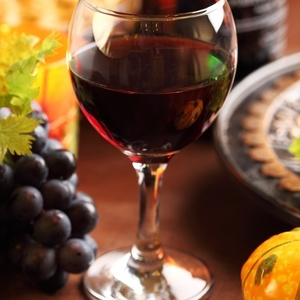
Falanghina is an old grape with a bright modern future. Greek settlers probably brought the grape to Italy when Rome was still a fortified village and soon discovered that it thrived on the rocky, volcanic soils of Campania north of modern-day Naples. As first the Republic and then Empire expanded, Romans continued to cultivate Falanghina along with the region’s other most successful grapes, Aglianico and Piedirosso.
The Romans soon discovered that Falanghina vines did best when trained to grow up wooden stakes, called in Latin “falangae,” the source of Falanghina’s name.

The Famed Falernian of Ancient Rome
While not certain, it seems likely that Falanghina was one component of Rome’s most famous and sought-after wine, Falernian. This seems to have been a late-harvest blend of grapes, made with considerable residual sugar, and aged for decades in clay amphorae. As it aged, the got more concentrated and exposure to heat and oxygen probably resulted in a sweet wine much like modern Madeira.
And, it packed a punch – Roman authors frequently commented that Falernian had so much alcohol that it was the only wine that could be set on fire with a match!
The same volcanic soils that allowed Falanghina to thrive spelled doom for much of the region’s vineyard when Mt. Vesuvius erupted in 79 CE, covering both the city of Pompeii and its surrounding farms in lava and ash. The disaster extended down to the vineyards northwest of Naples where Romans had planted grapes alongside the bubbling craters of a second volcanic area called “Campi Flegrei” or “the Phlegraean Fields.”

Replanting in a Moonscape
Over the years, first Roman and then Italian farmers replanted vineyards in the Campi Flegrei moonscape (although an eight-day eruption here in 1538 set things back a bit). The region remains active, with more than 100 identified pools of water and mud still bubbling up gas and steam.
But, the porous, well-drained soils remain excellent for growing top-quality grapes. And, the high levels of sulfur in the soil are toxic to the phylloxera louse, meaning this is one of the few areas of Italy where vinifera grapes can still grow ungrafted on their own roots.
The Farro family had lived in Naples and the surrounding countryside for years before Michele Farro’s grandfather first established a winery in the hills overlooking the Phlegraean Fields in 1926. As Michele assumed control of the estate, he became a champion of the region (he now heads the DOC’s board) and of its classical grapes: Piedirosso and Falanghina.

A Modern Classic
Over the years, Michele and his family have carved out vineyards right on the edge of active volcanic craters by the sea and running up to terraces hacked out of volcanic rock up to 1,800 feet above the Fields and also down vineyards covered in talc-like powdered pumice. Where possible, Michele vineyards grow on their own rootstocks, and some of the vines in the lower vineyards are probably 100 years old (or more!).
Throughout the vineyards, Michele farms as naturally as possible and uses modern winemaking techniques with care to preserve the very best features of his Falanghina grapes. His 2020 Campi Flegrei DOC Bianco is a fantastic introduction to both the region and the vine. From first sniff to last sip, it’s clearly a wine of both volcanic and seaside origins – you’ll find loads of rocky, saline, minerality throughout this wine. But it’s also a wine of fine purity and lovely fruit, with plenty of bright peach, apricot and tangy pineapple flavors and a bracing squirt of lemony acidity at the end.
It’s hard to find something better to drink at with a sizzling plate of shrimp scampi or just-fried baby calamari (as my experience on Michele’s porch this summer proved). And, it’s sure to will delight with pasta laced with fresh vegetables or even fennel-spiked Italian sausage.
But we also think it’s pretty darn delicious all by itself, offering a captivating blend of richness and fruit to go with bright, refreshing, acids and minerality. Fine wine, fine value. Get some today!



 Not sure what wine you want to put out on the table with the big bird and all the fixings? Here are some fool-proof strategies for picking great bottles to share with family and friends before, during, and after the big meal:
Not sure what wine you want to put out on the table with the big bird and all the fixings? Here are some fool-proof strategies for picking great bottles to share with family and friends before, during, and after the big meal: Power Through – It’s a big meal, so match it with full and fleshy wines bursting with bold flavors. American Zinfandel and California Pinot Noirs are the classic suggestions here. But bold Rhone reds like Chateauneuf du Pape and Cotes du Rhone are just as much fun. You can find great value in Spain’s Tempranillo and Monestrell grapes or add a bit of luxury by going with powerful Priorat or even majestic Brunello di Montalcino.
Power Through – It’s a big meal, so match it with full and fleshy wines bursting with bold flavors. American Zinfandel and California Pinot Noirs are the classic suggestions here. But bold Rhone reds like Chateauneuf du Pape and Cotes du Rhone are just as much fun. You can find great value in Spain’s Tempranillo and Monestrell grapes or add a bit of luxury by going with powerful Priorat or even majestic Brunello di Montalcino. Bring on the Bubbles! – It’s 11 am, the oven is cranked, pots are simmering on the stove, maybe you’ve just come in from setting up the turkey fryer – just imagine how good an ice-cold glass of fizz will taste! Sparkling wine is welcome at every table all year ‘round. Maybe start with some friendly Prosecco or Cava pre-dinner, then step up to rich, toasty Champagne to enhance stuffing and sweet potatoes. And nothing will make the dinner table look more elegant (or those way too heavy mashed potatoes go down easier) than pretty pink rosé fizz in every glass.
Bring on the Bubbles! – It’s 11 am, the oven is cranked, pots are simmering on the stove, maybe you’ve just come in from setting up the turkey fryer – just imagine how good an ice-cold glass of fizz will taste! Sparkling wine is welcome at every table all year ‘round. Maybe start with some friendly Prosecco or Cava pre-dinner, then step up to rich, toasty Champagne to enhance stuffing and sweet potatoes. And nothing will make the dinner table look more elegant (or those way too heavy mashed potatoes go down easier) than pretty pink rosé fizz in every glass.
